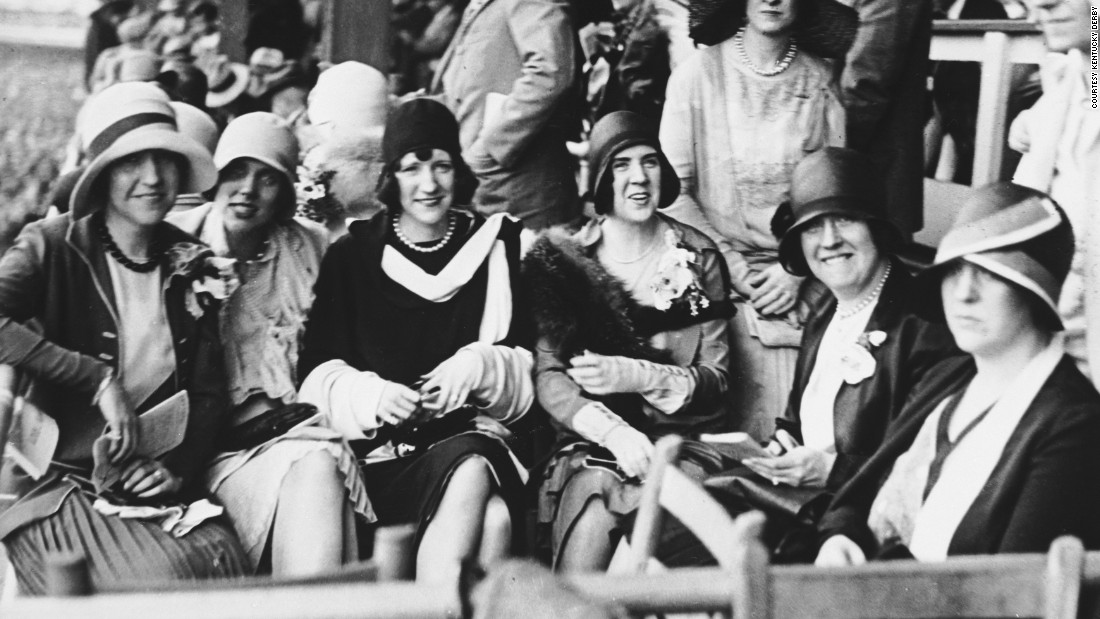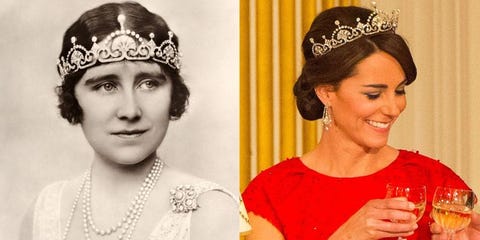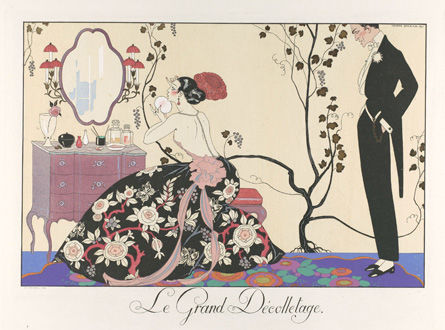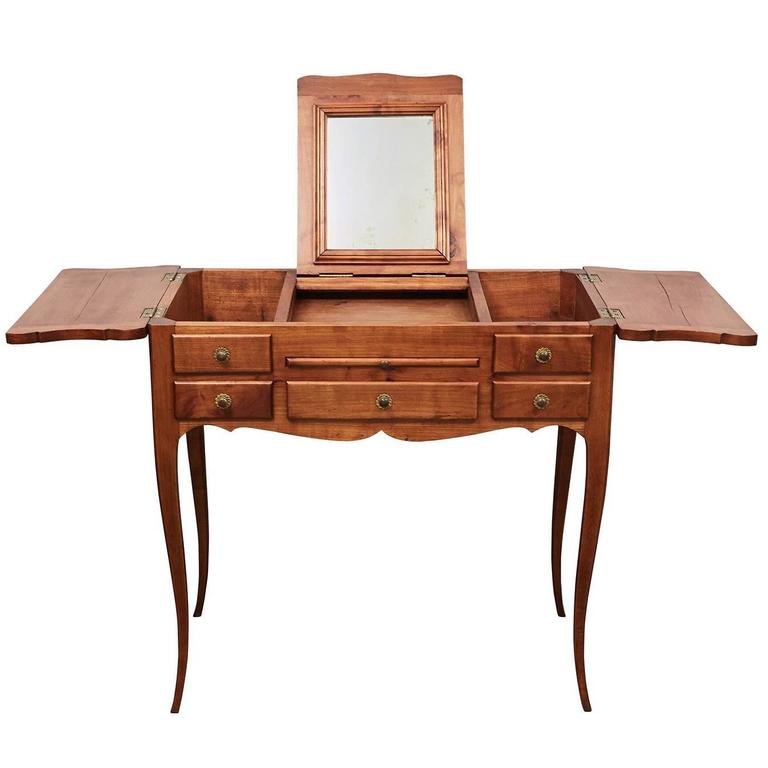talkingfashion » 1920
-
Fashion Flashback: The Hot History of Hats
Fashion Flashback: The Hot History of Hats
By Paige McKirahan
To continue on with our historical evaluation behind some of the most iconic accessories of all time, it would only be appropriate to reflect on how hats came to be in celebration of Hat Day! Whether they be worn for fashion, protection, ceremonies, rituals, or utilitarian purposes, these head coverings have been a staple in the industry for thousands of years. Of course, this long history starts in ancient Egypt; one of the first images depicting a hat can be found in Thebes tomb and this illustration shows a man wearing a conical straw hat. They also first appeared in an early illustration of Pileus which depicted him wearing a simple small cap.

Ancient Egyptian Headwear (source)
In this time and throughout history, one of the most popular materials for hats is felt. The ancient Egyptians and Native Americans first discovered this material when they discovered that camel hair, when compacted into the floors of their sandals, contributes to the creation of this material. St. Clement, the patron saint of felt hat makers, was said to encounter the material in a similar fashion after filling his shoes with flax fibers.
In these ancient times, hats were generally worn either to signify high status or for protection from the elements. In Ancient Rome and Greece, Phrygian caps also referred to as Liberty caps, were used as symbols of freedom for exonerated slaves. The first brimmed caps were found in Ancient Greece and were worn by those seeking to protect themselves from the sun, typically those working in fields or in construction.
As headwear began to evolve, gendered styles came into play during the Middle Ages; women were wearing a variety of new head covering designs ranging from veils to wimples. Later in those years, women’s hats transformed into elaborate displays of wealth that sometimes featured two horn-like decorations or conical shapes.

Middle Ages Hat Styles (source)
The 18th century birthed newer designs created by milliners; the term was created to describe products made in Milan and other Northern Italian regions that were made with high-quality materials. One of the most popular hats of this time was the Shepherdess hat, which featured a large, sun-blocking brim. Bonnets were as popular women’s in fashion as top hats were for men, and both were made from silk at the time. Silk top hats were so popular and awe-inspiring that a man wearing once caused such a stir in the streets he earned himself a 500 dollar fine from inciting panic!
In the following century, hat’s widespread popularity began to rise and was considered to be very fashionable as more designs become available. Women’s hats started growing in size and opulence with many including feather details, circular constructions, and varying brim styles. Brim sizes saw a decrease with the introduction of the parasol umbrella, and then grew again as the 20th century grew closer. Hats also began adapting to popular hairstyles, accommodating new cuts and fashions as to not disturb one's overall look. The first Kentucky Derby occurred in this century and established itself as the largest hat fashion event in America (and it still is to this day!).

The 20th century saw hats in a new light entirely. Wars, constant rationing, and accompanying social and cultural changes had a huge impact on all aspects of fashion, including headwear. The cloche hat peaked in popularity, and round hats with decorative flowers were another favorite of fashion lovers everywhere. Towards the middle of the century, fashion icons like Jackie Kennedy popularized the pillbox hat, which was followed by the fedora for both genders. Berets, top hats, sombreros, western hats, and ball caps all fluctuated in popularity during this time, and some of these styles are still very well received by the public.
Today, hats are still a hugely popular accessory and have been made staples in many sporting, cultural, and social events. They aren’t typically worn for ornamental purposes with as much gusto as they once were, but sports caps, beanies, and sun hats are beloved accessories for casual wear in modern times. To get a piece of fashion history to have as your own, check our collection of hats
Happy Hat Day TalkingFashion Peeps!
Sources:
A Brief History of Hats. (2011). Retrieved from http://hatbox.com/hat-history.cfmHistory and Origin of Hats. (n.d.). Retrieved from http://www.historyofhats.net/hat-history/who-invented-hats/ -
The Heady History of the Hand Fan
The Heady History of the Hand Fan
By Paige McKirahan
When considering all of the accessories that are used for both utilitarian and decorative purposes, one of the first to come to mind is that of the hand fan. Though this ornamental piece was widely popular in Victorian Eras as a foreign symbol of wealth and class, their origin lies centuries prior in ancient Egypt, Greece, and Rome. After two elaborate fans were discovered in King Tut’s tomb, their gilded appearance solidified the fan’s prominent presence in the accessory world.

(photo credits to pinterest.com)
The fan, which was originally thought be a sacred instrument, was used in religious ceremonies and by royalty in noble settings. They were also used in China in association with ancient mythical and historical characters. At their conception, they were fixed and remained as so until Chinese culture birthed the folding fan and spread it westward towards Europe. Both Chinese and Japanese legends credit their respective countries with creating the piece; the Japanese feel that the folding style is modeled after the wings of bat, and the Chinese legend claims the idea stemmed from a woman fanning her face at a festival.

(photo credits to clickpicx.com)
The 17th century then saw an increase in the use of folding fan, eventually causing fixed fans to become obsolete. This style was brought to Western cultures by merchant traders and religious missionaries, and prompted the development of the printed fan, which was made available to all classes. They generally featured prints of all kinds, either painted or transferred on, and shifted from biblical tradition to contemporary pastimes. The Impressionist, Art Nouveau, and Art Deco movements highly impacted the design and construction of fans from the 19th to the 20th century . The 19th century boast some of the most lavish fan designs in history and they were usually hand painted, furnishing those in royal positions. In the 20th century, feathered fans became popularized by those in high society and ostrich plums could be see floating through the air at every Moulin Rouge show!
Even though fans are not presently part of the everyday fashionista’s accessory arsenal, they still can be seen at royal events and in haute couture shows. We here at TalkingFashion think that something so grand should never go out of style, so to get your own fashionable fan, check out our fantastic collection here!
Sources:
History of Fans. (n.d.). Retrieved from https://www.thefanmuseum.org.uk/fan-history
A Brief History of the Hand Fan. (2008). Retrieved from https://web.ics.purdue.edu/~salvo/@SEA/exhibit/history.asp
-
The Grand History of Gloves
The Grand History of Gloves
By Paige McKirahan
In the accessory world, there are many pieces that have lifespans spanning centuries back to primitive ages. Can you guess which one we will be discussing today? As we head towards colder months, one of the most widely worn pieces conceived in ancient times is seeing an influx in use. Hats or coats may be the first things that come to mind, but it is actually the history of the glove that we are looking to dive into!
As a major piece in the fashion accessory puzzle, we first heard of the the glove when it was incriminated in the History of Herodotus (440 B.C.E.) and discussed as protective wear in The Odyssey by Homer. Ancient Egyptians typically used gloves as protective garments while working, but Pharaohs sported them to symbolize their high status. Women in this time wore the piece to protect the beauty of their hands, and they were made as a sort of small “pocket” with no holes for fingers; essentially, they were similar to today’s mittens and allowed women to maintain a feminine look.

Gloves found in King Tut's Tomb
(photo credits to pinterest.com)
Moving away from this more general use, gloves began being integrated into religious rituals. Bishops began a tradition of wearing them for Holy Sacrament, and their presence in religion can be traced all the way back to the 10th century. Popes, cardinals, and bishops wore them to keep their hands clean for holy ceremonies, prompting Kings to adopt the same practice when conducting royal business. Royalty also took cues from ancient Egyptians and later used gloves as an ornamental accessory to exude wealth and luxury. As we move towards the 13th century, they made their way in to royal women's fashions and common fabrics included silk or linen, featuring lengths reaching the elbow. By the 16th century, Queen Elizabeth brought bejeweled gloves to the forefront as a sought after trend, taking the normally simple accessory to previously uncharted territories.

Glove from the Holy Roman Empire
(photo credits to inesgloves.com)
In the 1700s, short sleeves came into circulation, prompting gloves that reached halfway up the forearm to become popularized. This style was on trend well into the next century, when gloves were more popular than ever before. Buttoned silk, kid (soft leather), or velvet gloves paired with evening dresses were customary, and longer suede gloves could be seen during the day during tea. At this point, the accessory was still being made mostly by hand, as most manufacturers opted out of using the complicated sewing and pressing machines available at that time. At the conclusion of the 1800s, we saw innovations in the industry that caused the first sterilized medical gloves to be created in 1894; the first disposable latex gloves were later manufactured in 1964 by Ansell.
The 1900s saw the use of gloves transform entirely. At the beginning of this century, one of the first references towards criminals using gloves to hide fingerprints was made in 1905 and this mysterious affiliation has been highly present in the media ever since (think O.J. Simpson). The industry began seeing dramatic changes on account of the societal shifts in the first half of the century; the birth of old Hollywood and the popularity of starlet’s style in the ‘20s through the ‘50s made simple gloves a staple in any modern woman’s closet. Gloves were still seen as a symbol of elegance well into the 1960s, where they truly came into being a symbol of riches, hypocrisy, and official relations. After that decade, the popularity of gloves for purposes other than cold weather wear declined; the introduction and overall popularity of more simple clothes and jeans didn’t require the upscale accessory. We saw a brief popularity boost in the ‘80s, with fingerless, netted, leather, and neon gloves returning to storefronts as the grunge and hairband movements favored accessory laden outfits.


Marilyn Monroe and Audrey Hepburn
(photo credits to pinterest.com)
Today, gloves have continued moving away from their royal roots and have headed towards adopting a more casual position in the fashion world. In addition to their wintertime popularity, they have also become important parts of sport uniforms used in baseball, golf, football, racing, and a multitude of others. In fashion, there are three prominent lengths: wrist (matinee), elbow, and full length (opera). The most popular material is satin and stretch satin, and are commonly seen at formal events such as proms, weddings, quinceanera, cotillions, or confirmations. If you have any of these events coming up or you are just trying to prepare for the December snow, we here at TalkingFashion have you covered! Head over to our collection to get a set of gloves wonderful enough to make you feel like royalty!
-
Headpiece Heaven: Five Fabulous Ornamental Accessories
Headpiece Heaven: Five Fabulous Ornamental Accessories
By Paige McKirahan
When it comes to the evaluation of headwear as an accessory rather than something worn out of necessity, it can truly make or break an outfit. Adding a scarf or hat to compliment a piece is customary, but what about more lavish head ornaments that are typically sported by royalty or those strutting the red carpet? Read on to learn about hair and head ornaments that emulate opulence from the top down!
This eclectic headwear is a more decorative alternative to the hat. Its roots can be traced back the Renaissance where it was customary for Christian women in Europe to sport head coverings. The use of the term came into circulation to describe the evolutionary form of this headpiece towards the end of the 20th century. Presently, it is typically worn at events where hats are customary and is accompanied by formal attire. They are commonly worn by woman as a covering during church services, weddings, or horse racing events. They are seen in great volume at royal events and Princess Beatrice of York wore a piece to Prince William and Catherine Middleton’s wedding that was so unusual, it became an internet sensation!
Tiara:
A tiara is a specific type of crown that tends to be bejeweled and ornamental in style. Appropriate for formal occasions of the white tie variety, this headpiece originates in Persia as a status symbol. The use of tiaras in ancient times declined with the rise of Christianity, but they saw a revival in the 18th century when Neoclassicism popularized the accessory for female adornment. Despite the fact that this revival was geared toward royalty, this piece has also been worn by wealthy commoners. The style is popular in the costume jewelry industry where they are worn by women for special occasions including homecomings, proms, quinceaneras, pageants, or weddings.

(image credits to harpersbazaar.com)
Hairpin:
The hairpin can come in many forms, but its basic function remains the same: to hold one’s hair in place. Whether the piece is elaborate and ornamental or utilitarian like a bobby pin, they are essential in creating different hairstyles. Coming from ancient Egypt and China, they were worn by all genders and were essential to hairstyling. They can also be used to note one's social or marital status. Now, they have a more decorative appearance and can be in the form of a barrette, bobby pin, or classic long straight pin.

(image credits to pinterest.com)
This hair accessory can be considered a variation of the hairpin; it is decorative and functional, with its main purpose being to hold a hat to the head. It was invented in Britain in the early 1800s and after its conception, the demand grew so great that a machine was created so it could be mass produced. In the late 1800s, bonnets became widely more circulated than hats, forcing hairpins into the closets of millions. They continued growing in popularity until the early 1900s until women began using them for self-defense purposes. They then began being regulated and their length decreased in order to deter wearers from using them as weapons.
Crown:
As the most traditional of headpieces on this list, the crown is a symbolic headwear typically won by royals. They represent power, victory, honor, glory, and legitimacy, and are often emblematic of the monarchy. These pieces can feature natural motifs, and they often are adorned with an assortment of expensive jewels. There are a variety of crown types and they can be used in coronations, at state occasions, or during weddings. You can even find their style being copied for novelty events (think Burger King's kid crowns!)

(image credit to us.hellomagazine.com)
Has Megan Markel and Harry's wedding got you feeling headpiece crazed? We can sate your desire for this royal glamour from the top down! Take a look at our collection to find headpieces for every occasion!
-
Dazzling Dressing Tables: A Brief History of the Vanity
Dazzling Dressing Tables: A Brief History of the Vanity
By Paige McKirahan
Though the world of luxury furniture is very much alive and well, the type of pieces we see popularized now are worlds away from the specially crafted styles that previously dominated the market. If you are someone with cosmetics, accessories, or perfumes, it is likely that you have some sort of container to hold them all (or so we hope!). But, we ask, have you ever stored them in an ever-so-glamorous vanity?
The dressing table is one piece of furniture that reveals a great deal about the culture in its time; few other items tell us more about leisure pursuits, trends, and changing social customs than this. This is an ever evolving piece and it has held a variety of names including the dressing table, dressing stand, vanity, and toilet table. But, we wonder, where did this fashionable furniture come from and how did it achieve the elegant status is possesses today?

(photo credits to the metmuseum.com)
Of course, the vanity comes from humble beginnings in ancient culture; its earliest ancestor is considered to be ornate boxes that were crafted for holding beauty products in Egypt and Greece. The use of boxes for this storage purpose continued for centuries until the 1600s in Europe, where the early vanity began evolving. The original name of the piece was the toilet table and they were used in the bathroom for hygiene purposes with a wash basin for freshening up. High society in this century and into the next began wanting more delicate designs; they started commissioning specialized furniture pieces that were modeled after shaving tables, poudreuses, and the low boy. Poudreuses hailed from France; they boasted a small tabletop for holding perfume, along with a small amount of drawer storage for makeup. Low boys were more so popular in the U.S. and England and were often custom made. In addition to their decorative elements, they typically offered one or two rows of drawers for storage purposes.


Poudreuse (top) and Low boy vanity styles
(photo credits to pinterest.com)
As we headed towards the 19th century, these tables started to become larger with more decorative features. They now included mirrors and an increased number of drawers, making them a more cabinet-style. With their newfound function, they began being included in bedroom furniture collections and were commonly accompanied by a small stool. The variety of styles offered also increased in this century; colonial, Queen Anne, and Chippendale style vanities were elaborate and were often made of oak, walnuts, or mahogany. We saw huge art movement influence on these tables and many revivalist styles including Gothic, Elizabethan, Rococo, and Renaissance.
19th Century Rococo Vanity
(photo credits to inessa.com)
The early 20th century brought the Art Deco movement alive; this artistic style is synonymous with the 1900s rise of the vanity as luxurious dressing tables became the epitome of prestige. Old Hollywood films of the ‘20s and ‘30s painted a picture of a femme fatale sitting in her Manhattan apartment decorated with an elegant vanity table. Since then, vanity table's luxurious standing still prevails with influencers and couture queens alike creating entire rooms surrounding their vanity space. Do you have a vanity you are looking to fill! Well say goodbye to those empty drawers and hello to our collection for a solution any accessory lover would adore!








